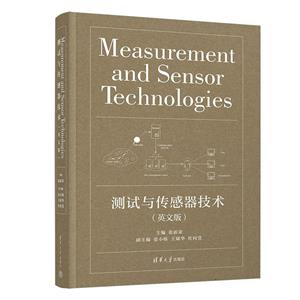-
>
通宵俱乐部-签名本
-
>
2022读者节纪念徽章-一星会员专属
-
>
20世纪中国短篇小说选集(全6册)(八五品)
-
>
(精)方力钧作品图录
-
>
“囤书者说”藏书印章系列-谢绝外借
-
>
(精)赵丹书画选
-
>
中图网文创礼包-“民国名家画谱”藏书票贴纸(2张)
测试与传感器技术(英文版) 版权信息
- ISBN:9787302601944
- 条形码:9787302601944 ; 978-7-302-60194-4
- 装帧:一般胶版纸
- 册数:暂无
- 重量:暂无
- 所属分类:
测试与传感器技术(英文版) 本书特色
测试与传感器技术英文版教材主要面向对象为机械工程学科相关类专业本科生、研究生和国际学生,也可给从事测试技术、传感器设计、信号分析、机电控制等教学研究的科研工作者提供参考。本教材特别适合应用于双语教学和全英文教学。 内容从简到深、形式形象直观、目标注重实用、手段结合实际。
测试与传感器技术(英文版) 内容简介
测试与传感器技术英文版教材主要面向对象为机械工程学科相关类专业本科生、研究生和靠前学生,也可给从事测试技术、传感器设计、信号分析、机电控制等教学研究的科研工作者提供参考。本教材特别适合应用于双语教学和全英文教学。本教材分为3篇,工程测试基础、常用传感器原理及应用、新型传感与检测技术。工程测试基础篇主要介绍测试技术的基本概念、测试信号及其分析方法、信号调理、显示与记录、测试系统特性等;常用传感器原理及应用篇主要结合工程实例介绍常用的应变式、电感式、电容式、压电式、磁电式、光电式、热电式、辐射式和数字式传感器的工作原理及应用;新型传感与检测技术篇主要介绍一些**的传感技术,如微型传感器、智能传感器、光纤检测技术、生物电信号检测技术等。计划分19章编写,编写原则是内容从简到深、形式形象直观、目标注重实用、手段结合实际。
测试与传感器技术(英文版) 目录
Part ⅠFundamentals of Measurement Systems
Chapter 1Basic Concepts of Measurement Technologies
1.1Introduction
1.1.1Measurement, metrology, and testing
1.1.2Classification of measurements
1.1.3Structure of measurement system
1.2Measurement uncertainty
1.2.1The concept of uncertainty
1.2.2Measurement uncertainty sources
1.3Measurement errors
1.3.1Errors
1.3.2Systematic errors
1.3.3Random errors
1.4Statistical analysis of measurements
1.4.1Mean and median
1.4.2Standard deviation and variance
1.4.3Standard error of the mean
1.4.4Rogue data points
1.4.5Aggregation of measurement system errors
1.5Mathematical regression techniques
1.5.1Linear least squares regression
1.5.2Polynomial least squares regression
1.6Summary
Exercises and Problems
Chapter 2Signal Analysis
2.1Classification of signals
2.1.1Deterministic signals
2.1.2Random signals
2.1.3Continuoustime signals and discretetime signals
2.1.4Typical signals
2.2Fourier series of periodic signals
2.2.1Fourier trigonometric series
2.2.2Exponential Fourier series
2.2.3Frequency spectra of periodic signals
2.3Fourier transforms
2.3.1Fourier transforms of aperiodic signals
2.3.2Fourier transforms of periodic signals
2.3.3Properties of Fourier transforms
2.4Random signals description
2.4.1Characteristic parameters for random process
2.4.2Correlation analysis
2.4.3Power density spectrum
2.5Summary
Exercises and Problems
Chapter 3Signal Conditioning
3.1Introduction of signal conditioning
3.1.1Filtering
3.1.2Amplifying
3.1.3Isolation
3.1.4Modulation
3.2Filtering
3.2.1Simple lowpass filters
3.2.2Simple highpass filters
3.2.3Simple bandpass filters
3.2.4Simple bandelimination or bandreject or notch filters
3.2.5Design of passive filter
3.3Modulation
3.3.1Amplitude modulation
3.3.2Angle modulation
3.3.3Matlab Codes
3.4Summary
Exercises and Problems
Chapter 4Basic Characteristics of Measurement Systems
4.1Measurement systems and linear systems
4.1.1Basic requirements of measurement systems
4.1.2Linear systems and main characteristics
4.1.3Transmission characteristics of measurement systems
4.2Static characteristics of a measurement system
4.2.1Sensitivity
4.2.2Linearity
4.2.3Hysteresis
4.2.4Repeatability
4.2.5Accuracy
4.2.6Drift and stability
4.2.7Resolution
4.2.8Calibration
4.3Dynamic characteristics of a measurement system
4.3.1Mathematical description of dynamic characteristics
4.3.2Firstorder measurement system
4.3.3Secondorder measurement system
4.3.4Calibration of dynamic characteristics of systems
4.4Conditions of distortionless measurement
4.5Summary
Exercises and Problems
Chapter 5Outline of Sensor Technologies
5.1Basic concepts of sensors
5.1.1Definition and composition of sensors
5.1.2Function of sensors
5.1.3Classification of sensors
5.1.4Basic characteristics of sensors
5.2Sensor calibration
5.2.1Fundamental concepts
5.2.2Basic methods
5.2.3Calibration system
5.3Principles of instrument selection
5.3.1Characteristics of sensors
5.3.2The environment of measurement
5.3.3Cost and maintenance
5.4Applications and development trends of sensor
5.4.1Main applications
5.4.2Development trends
5.5Summary
Exercises and Problems
Part ⅡTraditional Sensors and Applications
Chapter 6Resistance Strain Sensors
6.1Overview of resistive sensors
6.2Working principle of resistance strain sensor
6.2.1Resistance strain effect
6.2.2Piezoresistive effect
6.3Resistance strain gauges
6.3.1Structure and materials of resistance strain gauges
6.3.2Main characteristics of resistance strain gauges
6.4Key problems of resistance strain gauge engineering application
6.4.1Pasting process of strain gauges
6.4.2Measurement circuits
6.4.3Temperature error and compensation
6.5Summary
Exercises and Problems
Chapter 7Inductive Sensors
7.1Introduction
7.2Selfinductance inductive sensors
7.2.1The singlecoil linear variablereluctance sensors
7.2.2The variabledifferential reluctance sensor
7.2.3Variablereluctance tachogenerators
7.3Mutual inductance sensors: LVDT
7.4Eddy currents
7.5Advantages/disadvantages of inductive sensors
7.6Applications of the inductive sensors
7.6.1Inductive proximity switch
7.6.2LVDT pressure sensor
7.6.3Flaw detection sensors
7.7Summary
Exercises and Problems
Chapter 8Capacitive Sensors
8.1Basic principle of the capacitive sensors
8.2Measuring displacement and velocity by changing overlapped
area and gap distance of capacitive sensors
8.2.1Using the change of the overlapped area between the
two plates
8.2.2Using the change in distance between the plates
8.2.3Capacitance bridge circuit
8.2.4Coaxial cylindrical capacitive sensor
8.3Variable permittivity capacitive sensors
8.4Measuring circuits of capacitive sensors
8.4.1Equivalent circuit of capacitive sensors
8.4.2Frequency modulation circuits
8.5Characteristics and application of capacitive sensors
8.5.1Characteristics of capacitive sensors
8.5.2Engineering application cases of capacitive sensors
8.6Summary
Exercises and Problems
Chapter 9Piezoelectric Sensors
9.1Piezoelectric effect
9.1.1Piezoelectric effect
9.1.2Piezoelectric materials
9.2Measure circuit
9.2.1Theory and model
9.2.2Signal conditioning circuit
9.3Piezoelectric sensors
9.3.1Accelerometers
9.3.2Force sensors
9.3.3Pressure sensors
9.4Application
9.4.1Principle of damping factor measurement
9.4.2Measurement system
9.5Summary
Exercises and Problems
Chapter 10Magnetoelectric Sensors
测试与传感器技术(英文版) 节选
测试技术被广泛应用在机械、仪器仪表、测控、自动化、航空航天、信息等诸多学科或领域。近期的大型工程: 我国的“嫦娥五号”月球探测器一次性完成对月球的“绕、落、回”,并成功实现月球轨道自动对接、月壤采集等高难度任务目标; 我国开启的火星探测计划,“天问一号”火星探测器一次性完成“绕、落、巡”三大任务; 我国高速铁路技术引领世界,其牵引传动控制系统是其核心技术; 美国太空探索技术公司的可回收运载火箭的成套技术; 美国特斯拉公司的无人驾驶系统等。这些具有重大国际影响力的项目,能够成功的主要原因就是人类在测试与控制的理论研究和技术突破方面的长足进步和成功应用,测控技术的*新发展使得人们可以去实现一些更加复杂且空前精细的重大任务。 测试与传感器技术是机械类专业本科生的必修课,*早称为非电量电测技术,后来被改为测试技术、工程测试技术、自动检测技术。考虑到传感器在测试技术中的突出地位,作者认为合称测试与传感器技术更为全面。21世纪初,中国教育部提出了要加强在本科教育中的英语教学的意见,很多高校都相继开设了双语教学课程。长安大学在机械电子工程专业本科生培养环节也制定了测试与传感器技术双语教学课程方案。为了满足双语教学对教材的需求,先后采用了引进国外原版教材和自己讲稿独立编写全英文讲义的方式。近年来,中国高校“双一流”建设任务目标对教育的国际化要求越来越高,另外,“一带一路”沿线国家的许多学生纷纷来到中国留学,对于国际留学生的培养也急需编写相应的合适教材。本教材的编写工作正是在这两大背景下提出的。 本教材可作为高等院校机械类、仪器仪表类、控制类、信息类等专业本科、研究生以及国际留学生的教材,也可作为工程技术人员的专业参考教材。 本教材分为3篇共19章。3篇是: (1)工程测试基础——介绍测试技术的基本概念、测试信号及其分析方法、信号调理、测试系统特性等; (2)常用传感器原理及应用——结合工程实例介绍应变式、电感式、电容式、压电式、磁电式、光电式、热电式、辐射式和数字式等常用传感器的工作原理及应用; (3)新型传感与检测技术——介绍微型传感器、智能传感器、光纤检测与生物电信号检测等*新的技术动态。 本教材19章编写分工如下: 第1、2章和附录——长安大学张新荣,第3章——哈尔滨工业大学黄其涛,第4章——陕西科技大学张航伟、祁广利,第5章——清华大学黄晋,第6章——长安大学董忠红,第7、16章——长安大学王斌华,第8章——吉林大学孔德文,第9章——长安大学张军,第10章——西北工业大学杜向党、吴萌,第11章——西安建筑科技大学刘沛津,第12章——长安大学李金平,第13章——西安科技大学曹现刚、薛旭升,第14章——西安理工大学王建平,第15章——长安大学张弛,第17章——西安交通大学张小栋、华北电力大学牛杭,第18章——西安交通大学张小栋、湖北理工学院尹贵,第19章——合肥工业大学董方方。全书统稿——长安大学张新荣教授。 本教材在编写过程中,参考和引用了许多专家学者的论著、教材以及学术论文,在此表示衷心感谢。另外,还要感谢长安大学阎贝博士、田远思博士的帮助,南京航空航天大学潘慕绚教授提供的合理化建议,感谢研究生陈婷婷、杨登科、王莹、宋碧娅、张宇、许权宁、谭宇航、杨薪宏、George Boadu、张香瑞、姜文涛、孙长贺、史洁琳、王柳月、郭子辰、晏东阳、金栋、王宇浩、吴彦岐等协助完成了资料查找、校对和部分绘图工作。*后非常感谢长安大学对本教材出版的资助,也感谢清华大学出版社编辑对本教材出版做出的贡献。 由于作者水平有限,书中错误和不妥之处在所难免,恳请广大读者批评指正。 作者 2022年2月
测试与传感器技术(英文版) 作者简介
张新荣,教授。长安大学工程机械学院副院长,工程机械国家虚拟仿真实验教学中心副主任,全国高校机械工程测试技术研究会常务理事,自动测试技术分会副理事长、常务理事,面向本科、研究生主讲测试与传感器技术(双语)、自动控制理论、现代控制理论、智能控制原理及应用、现代机械振动等课程。共发表学术论文60余篇,主编和参编专著及教材3部,以副主编身份编写《传感器与测试技术》教材1部,现在已是第2版。
- >
我与地坛
我与地坛
¥25.8¥28.0 - >
人文阅读与收藏·良友文学丛书:一天的工作
人文阅读与收藏·良友文学丛书:一天的工作
¥16.0¥45.8 - >
上帝之肋:男人的真实旅程
上帝之肋:男人的真实旅程
¥19.3¥35.0 - >
我从未如此眷恋人间
我从未如此眷恋人间
¥37.4¥49.8 - >
龙榆生:词曲概论/大家小书
龙榆生:词曲概论/大家小书
¥9.1¥24.0 - >
伯纳黛特,你要去哪(2021新版)
伯纳黛特,你要去哪(2021新版)
¥23.4¥49.8 - >
小考拉的故事-套装共3册
小考拉的故事-套装共3册
¥35.4¥68.0 - >
有舍有得是人生
有舍有得是人生
¥21.2¥45.0
-
2022图书×抽奖盲袋
¥9.9¥25 -
2023读书月阅读盲盒——天黑,闭眼,刀谁?
¥42.3¥158 -
2022读者节纪念徽章-三星会员专属
¥45¥45.6 -
2023读书月阅读盲盒——我什么场面没见过?
¥42.3¥158 -
2023读书月阅读盲盒——去码头整点什么薯条?
¥42.3¥158















